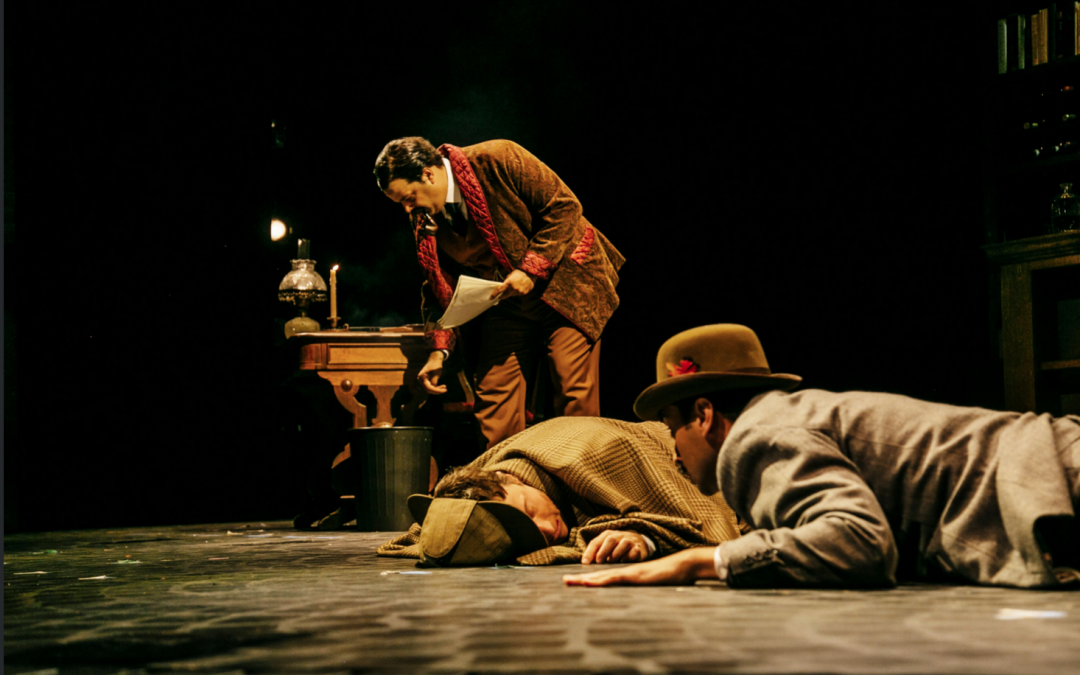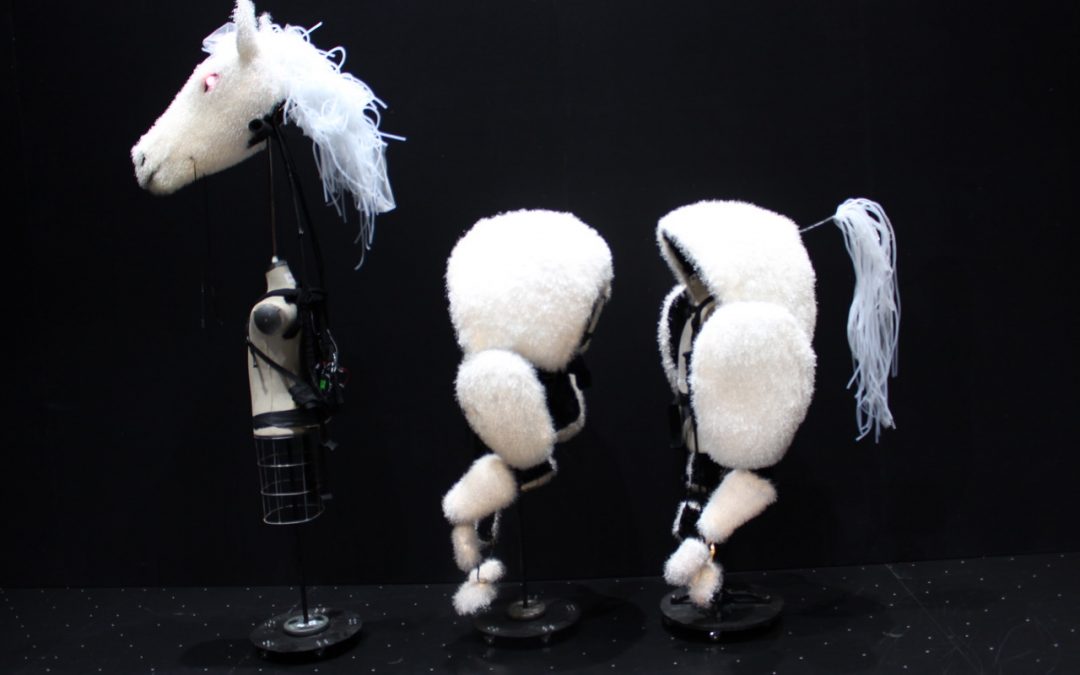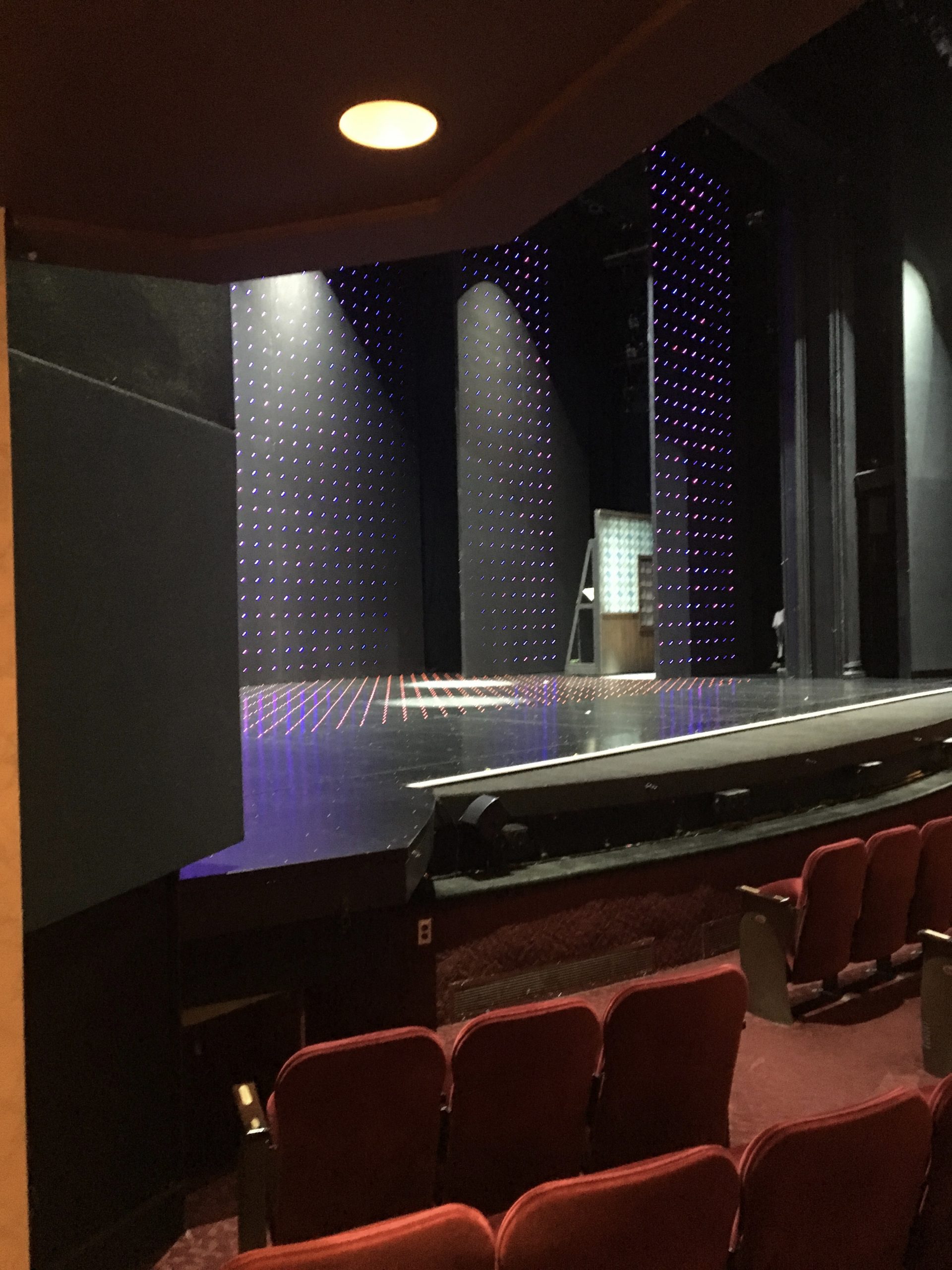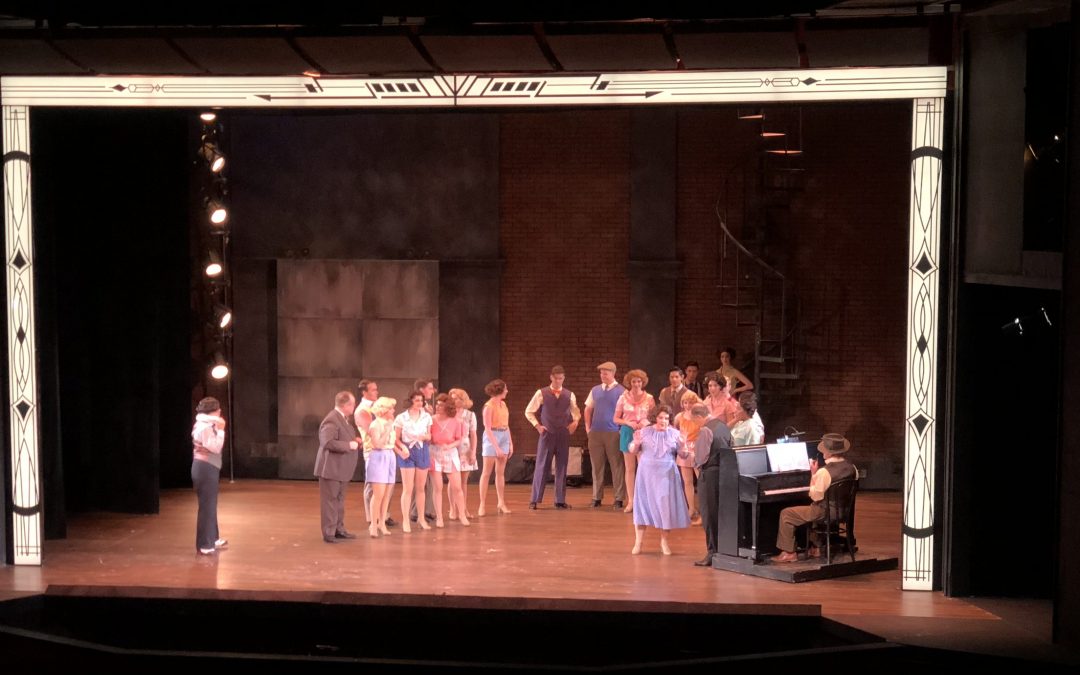
by boss | Sep 11, 2019
When it was time for the Geffen Playhouse in Los Angeles to mount their production of the drama ‘Mysterious Circumstances,’ which explores the death of the world’s foremost Sherlock Holmes expert — and includes Holmes himself — they turned to equipment from RC4 Wireless. “I have personally been working with RC4 products for 5 years now, but the theatre has been working with the gear much longer. We actually have an RC4 Wireless Series 2 transceiver packed away,” notes Ramine Ameli, Lighting and Projection Supervisor.
‘Mysterious Circumstances’ was chock full of action. “There ended up being a scene change every three minutes or so. So, having lots of different set pieces that could move around freely without wires really established every location,” notes Ameli.
As for the plot, “The show revolved around a box of unpublished Sherlock Holmes manuscripts, so we had three identical boxes equipped with different gags. All three boxes used an RC4 Wireless DMX2dim. The first box appeared to be floating during pre-show, and as the show began, the keyhole light-up -LED tape in a mold- and the box appeared to get sucked into the keyhole. The second version of the box had a glowing keyhole but did not open up. This was to have the audience associate this box with the one they saw in the beginning. The third version of the box had LED tape inside it to light up someone’s face as they looked into it,’ Ameli explains.
That wasn’t the only wireless used in the production. Ameli explains: “We had two tracking projections screens that were framed by brick columns that had up light scrapes and a streetlight; we also three bookshelf wagons that had additional street lights in them,” says Ameli. All were controlled via RC4 2.4GHz dimmers. “We also had a flying picture frame that had LED tape in it and a couple of furniture units that were carried on and dresses with lamps, an answering machine with a red blinking light, and a faux oil light lamp. We also had a mobile fireplace where we gutted a portable heater shaped like a log fire. It had several strips of LED tape in it – controlled via an RC4 DMX4dim – it also had a couple of birdies tucked away to send light out of the fire, and it was also equipped with a tiny fogger that received data via the 6mm DMX through the RC4 dimmer.”
For ‘Mysterious Circumstances,’ Ameli notes:” We used all of our two channel dimmers, and rented three four-channel dimmers.” Ameli has gone the rental route with RC4 before. “This is my second time renting from RC4, and every time it is a breeze. I love that you can assemble your order online and see how much it’s going to cost- which is always at a great price. I haven’t taken advantage of this yet, but the idea that you can purchase the equipment after renting, and have the price be lower is just fantastic.”
The rental department is an integral part of RC4 Wireless. “Renting is a great way for new wireless dimming and DMX users to give RC4 Wireless a try,” notes Aimee Wilson, Director of Customer Support at RC4. She adds: ”Renting is also a terrific budget-friendly option for people who already own RC4 Wireless products to expand their inventory for one particular show or project.”
In the past, she has reached out to RC4 when her team has had technical issues. “The first time I called RC4’s customer service, I was running two different shows with wireless concurrently. I was a little confused, so I gave customer support a call and they were incredibly helpful. Not only were they great to talk to, but the answers to my questions were so much simpler than I thought. The one-touch configuration is super well thought out,” she says.
As a veteran user of wireless DMX and dimming, Ameli says: “RC4 is hands down the best wireless system out there. I have a lot of people asking how we do it, and I always point them to RC4 Wireless. I have nothing but great words about RC4 products.”

by boss | Aug 30, 2019
In ‘The Neverending Story’, a young boy sneaks into a bookstore and his world gets transformed by a book that takes him on a fantastic adventure, along with Artax, his horse. As part of the stage production, Artax has to be able to transport from the stage back into the pages of the book, which isn’t an insignificant feat.
When ‘The Neverending Story’ came to the Avon Theater at the Stratford Festival, Master Electrician, Gregory Bride turned to equipment from RC4 Wireless to create his magical, pixel infused horse. “The horse was a crazy idea; we opened our big mouths and said we could do it with the RC4 DMXpix,” says Bride. The patented DMXpix is a pixel driver that can control up to 1000 pixels using a unique feature called keyframing while keeping the number of DMX channels to a manageable level. Bride continues: “I think we’re up to 8 meters of LED tape inside the horse, that is operated by three puppeteers and that’s a lot of pixels. The beauty of the DMXpix is our ability to mirror the outputs; otherwise we would be in trouble. We can arrange it so that what happens on the left side or the upstage side and the downstage side is identical.”
The technical aspects of the horse were handled by Electrician, Drew Rabbets. “I set up the horse for the show and determined the number of channels that are used. The DMXpix is great with its options in RC4 Commander configuration software. It was really easy to determine the type of product that is used and the number of channels as well as the starting address,” he explains. This is Rabbets’ first time with RC4 gear and the patented DMXpix pixel driver. “The RC4 DMXpix makes controlling a large number of pixels very easy with the double outputs, I was able to clone each output which cut the number of addresses in half, as well as the option of the keyframe makes it much easier on the console,” Rabbets adds.
The horse alone uses one universe of DMX. In ‘The Neverending Story’, we have four universes; the fourth universe being our test universe,” says Bride. There are another two universes in the Studio Theatre, which shares a wall with the Avon Theatre. That could mean wireless issues; that’s not the case, because the Avon Theater is using RC4 Wireless equipment. “One of the important things about RC4 for us is that we can do Private IDs,” Bride explains. Private IDentities are RC4’s trademarked way of keeping each and every RC4 wireless system safe from other systems. “All pro-grade wireless DMX technology provides some form of security, but none provide the flexibility of RC4 Private IDentities. Every customer and project is assigned a set of unique codes that belong only to them — your IDs can never interfere with anyone else’s. And the biggest benefit: when a forklift truck runs over your DMXio transmitter during load-in, you can grab another one, and not have to re-link all the receivers and dimmers in the show. There’s nothing else that is both secure and super serviceable, which is why Disney, Cirque du Soleil, Blue Man Group, and many others depend on RC4. RC4 can deliver up to 12 wireless universes in the 2.4GHz band, and 8 in the 900MHz band, all with superior range compared to other systems. With recent talk from others about multiple universes and more economical use of bandwidth, I have to point out that RC4 has been doing all of this for a decade already; as the designer, I’ve known for all that time that channel count, security, and bandwidth economy are paramount to our users,” notes RC4 Wireless CEO and Product Developer, James D. Smith. As for ‘The Neverending Story’, Bride notes, “We’re using three separate IDs at the same time, and we haven’t had any issues at all.”
The eyes of Artax the horse also play a critical role in the production. “The blue eyes on the horse are very important because the eye flies in the show. When the story is told in print, that eye disappears on the horse and it flies on the back screen, over to the storyteller and it goes into his book. So we had to be able to match the color on the horse on the back screen so it looked like that same color was flying on the back screen,” explains Bride.
The back screen is comprised of approximately 3000 pixels, and is hard wired. However, RC4 played a part in its creation. Bride explains: “We used RC4 gear to test the back screen; we used it to do all the testing and the proof of concept. Specifically, we used the DMXpix driver to prove the concept to the designers. We also had to be able to construct the screen very quickly in the design phase, which is why we used RC4 Wireless equipment.”
This is Bride’s first time with the DMXpix. Bride says, “I saw them in trade magazines, and as soon as I could, I ordered one. I knew that we would use it somehow.” His current inventory of RC4 Wireless 2.4GHz equipment is approximately 70 units. “You name it, we’ve got it in 2.4GHz; they work very well. We’re using approximately 40 of the packs for ‘The Neverending Story’; we even have one of the micro dimmers — the DMX2micro — in place in a headdress.” Rabbets adds: “I have been very impressed with the entire line of products; we are using a combination of the packs over 3 different transmitters and we have not had any issues.”
For those that are wireless curious, Bride has some advice: “Know what you’re trying to do first and then ask your questions. That’s the advice I give my techs. We’ll work something up and then solve our own problem. It’s usually not an RC4 problem.” Rabbet adds: “Anyone starting out with RC4 Wireless needs to take the time to really get to know the ins and out of the product and how you intend to use it. The RC4 Wireless system is not difficult but you really do need to understand how it works so when you get into a jam you can deal with it. The biggest thing is to have good decimation on a larger setup of RC4 units; with the DMXpix I took screenshots of RC4 Commander to ensure that the settings can be tracked.”
If, for some reason, there is an issue with the equipment, Bride – and all RC4 users – have the confidence of the RC4Magic Lifetime Warranty. Bride says: “That’s the great thing about the confidence that comes with the warranty. If we’re negligent with the product, we pay to have it fixed. We had a problem a while back, and when I called customer service, they immediately took care of it. A new unit was overnighted to us, so we had a spare.”
In terms of RC4’s customer service, Rabbets says, “I have had to call customer service several times as well as using the online service portal via email and my questions were very quickly answered, as we all know during production setup time is at a premium so a quick response is greatly appreciated.”
For Bride the best part of ‘The Neverending Story’ is the melding of technology and a story. “The technology is there to tell the story. The directors and designers had a clear vision, but the technology is there to tell the story. I love doing all these things, but when they support the story, it’s marvelous to work on technology when it is on a show where they are thoughtful. They came to us and said how do we do this and we said we’ll find a way to make it work.
And we did,” he concludes. 

by boss | Jul 17, 2019
In Europe, Robbie Williams is a legend; he regularly fills stadiums and his productions are some of the most anticipated on the continent. One of his dreams was to do a Vegas show, and to make every detail of Williams’ show perfect, Production and Lighting Designer Sean Burke, principal at Holes in the Dark, needed reliable wireless DMX technology. “When the wireless stuff came up, I did a bit of research on it, looked around, and saw that Baz [Halpin, of Silent House Productions] used RC4 Wireless products on the last Katy Perry tour. I know the crew chief, and he said they didn’t have any problems with it,” confides Burke. That was enough for him to entrust RC4 Wireless with the job for Williams’ “Live in Las Vegas” show. Matt Bakken, the Master Electrician on the show, adds: “When a lot of people in the touring industry use wireless, they use equipment from RC4; to me, if your wireless is working in a stadium with 25,000 plus people with cell phones, that’s good enough for me.”
For the Williams’ production, the team built their system around an RC4Magic Series 3 DMXio-HG Transceiver with External Antenna; working along with the DMXio are six RC4Magic Series 3 DMX4dim 4-Channel Wireless Dimmers. “Addressing was easy and very straight forward; pairing the receivers with the transceivers was simple as well. The system was exactly what I wanted and it just worked,” reports Bakken.
There are several props using the RC4 Wireless DMX4dims; specifically, two giant Martini glasses and four stylized box frames, called Gogo frames. “The GoGo frames are open aluminum frames that the dancers push around and dance inside. The Gogo frames and the Martini glasses have wireless receivers on board and battery packs, so they are completely wireless,” explains Burke. In terms of batteries, Bakken adds, “The batteries are lasting pretty much forever on them, and sometimes they forget to plug them in to charge them.” Both the Gogo frames and the Martini glasses were manufactured by ShowFX, who also handled the Katy Perry props.
“After working in the professional theatre world for a few years, I founded RC4 in 1991,” says James David Smith, also the Chief Product Developer. “Our DMX4dim wireless dimmers are the pinnacle of design, and can control LEDs, halogen lamps, position servo motors, ring telephones, and more. The RC4 ColorMatch feature lets you color-correct LEDs from different manufacturers to deliver the same color palette across all props and scenery.”
It’s no secret that Las Vegas is a busy wireless environment. “We have several wireless systems running concurrently; at no point did I see any signal degradation or interference,” says Bakken. Placement of the transceiver is also important. “I try to mitigate any potential issues by putting the transceiver right down by the proscenium on the stage, so there would be no problems. And there weren’t,” Bakken adds.
The ability to punch through crowded wireless areas is a fundamental part of all RC4 Wireless products. “The entire RC4Magic Series 3 system, starting with the DMXio-HG transceiver, uses proprietary wireless technology unlike any other,” explains Smith. “It consumes just 1/15th of the 2.4GHz radio band and punches through the noise like nothing else.”
There are many in the industry that are cautious of wireless dimming and DMX. “I know a lot of people who are incredibly wary of wireless because they have been burned in the past. When you’re using it, your wireless must work,” states Bakken. The RC4 products on Williams’ show proved their worth night after night. Bakken says: “RC4 gear works well and that’s all I can ask for. If you haven’t used it, you should give it a shot.”
Robbie Williams concluded his stint in Vegas on July 6th; however, the U.K. press reports that he’s close to inking a six figure residency deal there.

by boss | Jun 18, 2019
Production/Lighting Designer Jeremy Allen Fisher is a veteran RC4 Wireless user. “I started working with RC4 products in 2009 when I worked for the Santa Fe Opera for a summer, and then I started working with them heavily in 2011 when I started working for Theatre Memphis. I started with Series 2 and now I’m on Series 3,” he explains. Today, Fisher is at the Tennessee Shakespeare Company and is on the 2.4GHz line of products. Fisher continues: “At Theater Memphis, I had a two channel and two four channel dimmers, DMXpix units, four channel high power dimmer and two DMXio transceivers. Now I have one of the 6 channel DMX6dims, one 6 channel high power dimmer [a DMX6dim-500], one DMXpix and one DMXio transceiver.”
Fisher’s most interesting wireless project took place at Theatre Memphis. He picks up the story: “We made a low rez video wall using two RC4 Wireless DMXpix. I made these 1’ by 4’ wooden boxes; each one had eight rows of WS2812 LED tape in them. I made 15 of those boxes that all connected together to make a proscenium arch all the way around. Using the DMXpix to drive them, I was able to turn that into a low rez video wall and then run animation clips and video clips through the Ion console to get my content onto that to make color effects and things, rather than programming them individually and trying to do it that way.”
The modular system was decorative as well. “The boxes were covered with a plastic film that had images printed on it to give to an Art Deco feel and the boxes lined our proscenium. This film was very cheap and a local sign company printed it for us. It’s typically used in back lit LED signs, which made for nice smooth blending without much loss of output. This system was designed to come apart and rearrange, from show to show, just using different covers. So far, we have used this in 2 other shows. Each box has its own power supply and making it usable and stand alone in any configuration. The total cost — not including the DMXpix — was about $1200 to $1500.” The LED wall was created for their performance of 42nd Street in 2018. “Since we created them, we have used them in a variety of different orientations, including in ‘Hairspray’,” Fisher adds.
Fisher’s RC4 wireless units did more than dim without wires; they saved time. “Over my years at Theatre Memphis, I made a stock of different practicals; I just popped an RC4 unit into them and the unit was good to go. They were all quick rigs with Anderson connectors; all I would have to do is pop a battery in, put and RC4 dimmer on it and away it went. I put in time on the front on end, lamp in room, but when people asked for something like a lamp in the middle of the room, I already had choices for them. I was able to save myself time by having all these tools in my arsenal that I could pull out, pop in an RC4 dimmer into it and then away it went,” he explains.
The RC4 Wireless units are a newer addition to the Tennessee Shakespeare Company. “I only bought them last season, so I haven’t done much with them here yet; I did something simple with some MR16s. It wasn’t anything too fantastically amazing. There was a prop in the middle of the room that we couldn’t get cables to, so I made it wireless. It was a stone altar for Macbeth, and in the stone altar there were reservoirs of blood and the reservoirs were lit with MR16s to help them glow,” the designer notes.
As a veteran RC4 user, Fisher has some wisdom to pass along. “I think a lot of people think wireless unreliable. My RC4 equipment has never given me problems, and when there has been an issue, it’s never been the wireless portion or the product, it’s because I wired something wrong,” he explains. There is also the time factor. “I don’t think people know how much time these products can save you in terms of wiring. When you first look at wireless dimming, it can seem daunting, but you break it down, it can save a lot of time,” Fisher adds.
When there is an issue, RC4’s customer service is based in the US, and ready to help users find solutions. Fisher concludes, “There is nothing like the RC4 Wireless customer service in the entire industry. Nothing.”

by boss | May 23, 2019
Everyone’s wireless dimming and DMX journey is different. Kat Seaton, Lighting and Projection Supervisor at The Arizona Theatre Company tells her story:
I was working as an Electrician at Scottsdale Community College in 2013 when we had a production that needed wireless dimming; we went with RC4 Wireless. When we got the first products in the theatre, the directors were so excited they wanted to use it on every show. It’s a portable dimmer you can place in the middle of the stage. At the time, we purchased a DMXio transceiver and three DMX2dim wireless dimmers.
RC4 Series 2 products—which are oldies but goodies have been a big part of my next job at The Arizona Theatre Company. I work with a lot of young technicians, that are unfamiliar with these dimmers, and all that they can do. Often believing that if it is older technology that is not working, it is broken rather than learning about it. I work in theater, so I don’t have the budget of someone like Katy Perry or Pink so can’t get something brand new. We have to find ways to make things work, which is why I’m still using RC4 Series 2 products for the past 5 years.
Typically in my world, when there are problems with these dimmers, it’s operator error. When unexpected problems happen, people shouldn’t be afraid to call RC4’s customer service. When I’ve called, it’s been a fantastic experience. At one point when I called, I ended up talking to Jim [James D. Smith] which was kind of mind blowing. You don’t expect to talk to the developer when you call tech support. They are literally the people that have designed it and built it.
Our company performs in two different venues—The Temple of Music and Art and the Herberger Theater Center—and we do every production twice. We do it in Tucson first at the Temple of Music and Art, and then in Phoenix at the Herberger Theater Center. While the production is going on in Phoenix, we begin work on the upcoming production in Tucson. Consequently, we have double of almost everything. When we have a show that needs wireless, it’s typically for moving scenery pieces and we’re trying to reduce cable traffic or for props. We’ve used it on a number of shows over the years, including our recent productions of ‘Music Man’ and ‘American Mariachi’. RC4 gear isn’t sketchy or unreliable; in fact, it ended up being an incredibly versatile, handy tool for our theaters.





